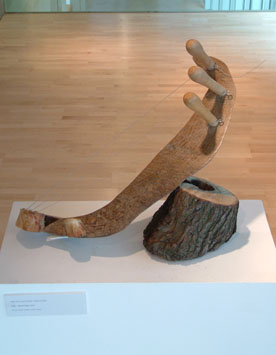Please note: some links on this page are in maintenance.
[Home]
[Education Project]
The background to Nigel Morgan’s Education Project for Yorkshire Scupture Park
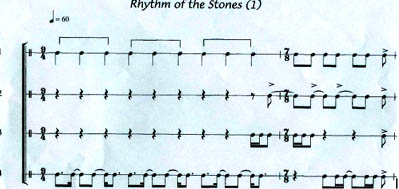
Musical Archaeology
Towards the end of 2002 Barbara Hepworth’s granddaughter Sophie Bowness began to research her grandmother’s love and interest of music for an essay she had been commissioned to write. Music and musicians had always been present in her family; her grandmother played the piano, reckoned a day was never complete without listening to music, and had close friendships and collaborations with several composers.
[Home]
[Education Project]
Looking through her grandmother’s collection of music Sophie Bowness was surprised to find a number of manuscript sheets signed by the South African-born composer Priaulx Rainier: a short work for keyboard titled To Barbara and three pages of sketches for a piece called Rhythm of the Stones. The keyboard piece found its way eventually into two compositions by Rainier: the Five Keyboard Pieces (1955) and the Six Pieces for Five Wind Instruments (1957). As for the Rhythm of the Stones, it was never finished. In fact we don’t know what the composer really wanted to do with the piece. It is not even clear how the music was to be performed. There is no instrumentation, tempo or dynamic markings. All we do know is that it was composed in Hepworth’s studio and that it appears to contain notations of the carving rhythms used by Hepworth and her two assistants. The rest is musical archaeology!
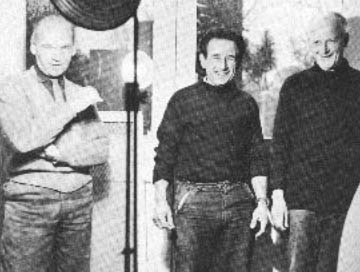
[Home]
[Education Project]
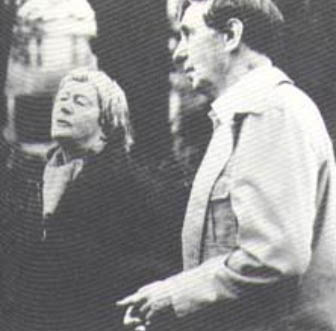
Priaulx Rainier and Michael Tippett
Music, Rhythm and Sculpture
Priaulx Rainier met Barbara Hepworth in 1949. It was through Rainier that Barbara Hepworth was introduced to many composers and performers who were later to become friends and collaborators. Some of the first sculptures by Hepworth that Rainier saw had musical titles such as Rhythmic Form. It was probably this sculpture that began their friendship.
If one had to say what musical element is most prominent in Rainier’s compositions a good case can be made for it being rhythm. Her music is full of rhythmic energy; it has rhythm that never settles into monotonous repetition; it is always changing, often with great subtlety and invention.
Rainier’s music speaks in a language of rhythm that has little in common with music of her time. Her musical language and grammar is probably closer to Africa than to Europe. This is maybe the reason why her music seems to move organically from one point to another. You rarely hear the regularly balanced and repetitious phrase structures found in most classical music, but instead experience a looser, more open-ended flow.
[Home]
[Education Project]
Sculpture, Rhythm and Music
From the time of her meeting with Priaulx Rainier, Barbara Hepworth seems to have been encouraged and inspired to think musically about her sculpture. When Rainier first visited Hepworth at her Trewyn Studio in St Ives the sculptor was working on a commission for The Festival of Britain called Contrapuntal Forms.
For a musician, counterpoint means literally note against note (from the Latin punctus contra punctum). For many centuries the art of music focused on the play and balance of one melody of music with another or others. This is known as contrapuntal music. It required great skill and craft to compose ‘good counterpoint’ and the music of composers writing in the late 16C (Palestrina, Lassus, Byrd) demonstrates just how far this composing with multiple melodies had been taken.
By the 18C counterpoint was an art that had its own rules and theories and even though contrapuntal music was considered ‘old fashioned’ it was recognised as an essential skill to be acquired by every musician.
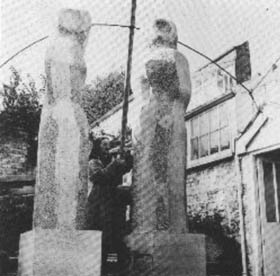
[Home]
[Education Project]
In the 20C counterpoint has developed a broader meaning. Here is Thomas Rowell’s description from his Thinking About Music:
Rarely is a work of art so simply organised that all of the important activity occurs in one area or along a single plane; we cannot fully experience a painting by looking only at its left edge, or a play by following the action and lines of a single character – or music by simply following the tune. The spectators must learn to shift attention because the works themselves shift the locus (place) of their activity.
In the music of Bach, which Hepworth loved and played on the piano, counterpoint becomes the friend of harmony and rhythm and often achieves a very special intimacy, as though two or more people are thinking what they are saying simultaneously. The listener can move effortlessly between one strand and another always hearing the resulting mix differently.
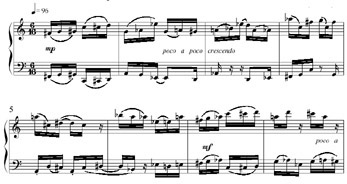
Listen to this example from Nigel Morgan’s Rising, Falling, Hovering (after the painting by Paul Klee) in which the balance between two parts (high and low) is constantly adjusted to highlight ‘the contrapuntal form’.
[Home]
[Education Project]
Percussion, Timbre and Rhythm
One of the major innovations in musical performance in the last century has been the use and variety of percussion instruments. From Messiaen’s fascination with the sounds of the Balinese Gamelan at the Paris Exposition Coloniale of 1931 to the experiments of Harry Partch, Edgar Varese and John Cage, percussion has become a rich resource for composers not only to highlight rhythm but to colour their music with exotic timbres, attacks and resonances.
The standard percussion ensemble is usually described in families of instruments: skins, woods, metals and noise instruments. Some are tuned (like timpani, xylophone, vibraphone, siren), some untuned (bass drum, guiro, cymbals, thundersheet).
There is a large and varied repertoire now for percussion ensembles ranging from two to over sixty players as well as dedicated ensembles such as Ensemble Bash, Nexus, and the Safri Duo. We hope this first realisation of Rhythm of the Stones will become a part of that repertoire.
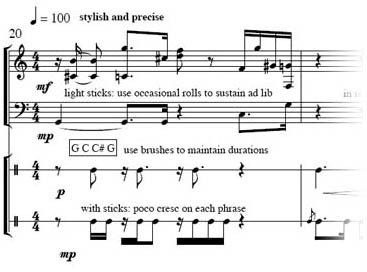
Listen to a recording of Nigel Morgan’s Seven Magical Preludes for Percussion Ensemble composed for percussionists of BBC National Orchestra of Wales.
[Home]
[Education Project]
Turning Rhythm of the Stones into Music
During May and June 2003 YSP Education made Priaulx Rainier’s Rhythm of the Stones come to life – in the hands of 30 students from City College, Wakefield. The objective is not only to create a live performance, but make a recording AND an installation as part of the Barbara Hepworth Exhibition.
To do this YSP brought together a team of musicians and sculptors to work with City College students to piece together (like good archaeologists) the evidence needed to make this unique piece of music come to performance over fifty years after it was imagined.
Over an intensive four-week period during May and June 2003 the composer and a sculptor from the YSP Education team collaborated with the Head of Wakefield’s Music Service, a professional percussionist, and staff and Year 7 students from City College. The challenge facing this team was, not only to bring the music together, but also to see if, using aspects of digital technology, it might be possible to incorporate the very sounds of carving into a musical performance.
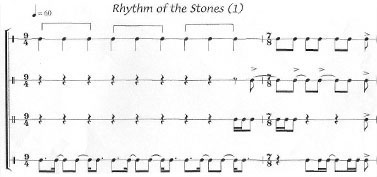
Listen to an extract from Rhythm of the Stones. This version was performed by school percussion ensemble and master drummer. The ensemble played varied orchestrations upon the core rhythmic patterns shown above.
[Home]
[Education Project]
Towards a Performance
The aim was to create two performance versions of Rhythm of the Stones:
- for a group of student ‘sculptors’ playing the original Rainier notations on devised instruments and ‘surfaces’ that come close to the real sound of sculptors carving. This was to be recorded as part of an installation, and performed as an insert into Nigel Morgan’s The Present Moment is the Only Real Time which quotes from Hepworth’s principal carving rhythm;Listen to The Present Moment is the Only Real Time recorded in Wakefield Cathedral on 10 January 2003.
- for four groups of student percussionists (16 players) playing standard percussion instruments and laptop computers. This was to be an extended version of Rainier’s original notations that also paid homage to her childhood in north eastern Natal, often known as Zululand, and the techniques of Steve Reich. This version included a processional chant (from Rainier’sUbuzima) and was to be performed in the main concourse of YSP’s Visitor Centre on 14 June 2003
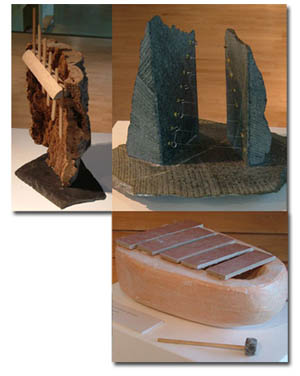
Some of the collection of instruments built to be part of the Rhythm of the Stones installation and played in The Present Moment is the Only Real Time.
[Home]
[Education Project]
Session Diary / Music
Here’s a brief resume of how the performance was put together

Session 1
Forming and playing percussion quartets. Demo from percussionist Matthew Williamson on techniques of percussion ensemble playing: how to count, key time, keeping a part, how to listen to four different lines at once! Percussion playing with the voice! – learning to vocalise (tricky) rhythms led by WMDC Music Advisor Geraldine Gaunt. Demo from composer Nigel Morgan on composing with rhythms using technology.
Session 2
Quartet playing – the African influence. Playing loops and cycles. Demo from Matthew Williamson on choosing appropriate instruments from the Music Centre collection and further performance techniques for ensemble playing. Percussion and Laptop music – playing to sequences and samples. Demo from Nigel Morgan and Phil Needham on how to compose and play with additive rhythms and syncopations.
Session 3
Starting work on Rainier’s score. Learning the rhythms! Listening to each group’s part. Deciding on instrument scoring. Blending in and triggering samples of carving recorded by the ‘sculptors’.
Session 4
Bringing the Quartets together into a full ensemble with WMDC Music Centre Percussion Instruments. Intensive rehearsal for recording and performance.
[Home]
[Education Project]
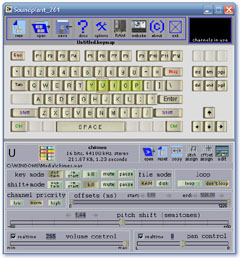
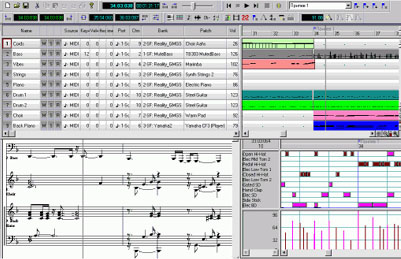
Information and Communications Technology is a core part of the current student learning experience. It is also an invaluable resource for making things happen in a creative situation. Auditioning and viewing music can happen really efficiently on a computer where a staff notation display of a score can be ‘played’ and edited as a rehearsal aid.
Rhythm of the Stones used ESP’s Compose software as a starting point for devising starting and reference points for the four percussion quartets and auditioning rehearsal sequences. In the latter stages of rehearsal Cakewalk took over as the preferred scorewriter for devising percussion scores and parts.
Samples of carving sounds in stone and wood were edited in Cool Edit, and Sonic Arts Network Sound Experience CD, and triggered live with SoundPlant2. Samples were uploaded into the library of Salford University’s Composers Experimental On-Line Suite where they were further processed with tools from Composers Desktop Project.
[Home]
[Education Project]
Publications & Downloads
Rhythm of the Stones – music for percussion quartet (and optional soprano sax)
After notations by Priaulx Rainier of carving rhythms used by Barbara Hepworth and her assistants.
15 min
Rhythm of the Stones – version for school percussion ensemble
12 min
Performance Score, Parts, Information Booklet and CD-R of the first performance MP3 Extract [mp3]
Available from the Education Department of Yorkshire Sculpture Park.
Music Rhythm and Stone
A collection of resources, examples, images, music and texts.
Prepared for a Study Day at Yorkshire Sculpture Park on 30 August 2003
as part of the Barbara Hepworth centenary exhibition
Available from the Education Department of Yorkshire Sculpture Park.
The Present Moment is the Only Real Time – version for girls’ choir and electric piano
Words by Dame Barbara Hepworth
More information here.
9 min
Study Score [pdf]
Recording of the first performance in Wakefield Cathedral [mp3]
